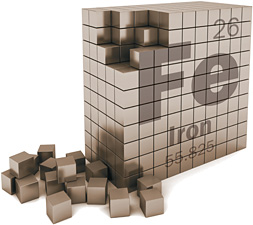Anemia caused by a lack of iron is known as hypochromic microcytic anemia. The reason for this series of articles is that people need not have anemia to suffer from a multitude of symptoms caused by inadequate iron.
To some practitioners, the term subclinical means before symptoms are present. Others were taught that subclinical is a period with varying degrees of symptoms prior to a clinical state. In the case of iron, symptoms are often present, even though the most commonly used indicators on a complete blood count (CBC) with differential - hemoglobin, hematocrit, mean corpuscular hemoglobin concentration (hypochromic when anemic) and mean corpuscular volume (microcytic when anemic) - can be within normal ranges. This is compounded by the incorrect and often repeated assumption that symptoms of iron deficiency will not appear until a person is anemic.
 Uptake
Uptake
Iron is absorbed from food and carried in the blood by a protein made in the liver called transferrin. Iron absorption is affected by both stored levels and food sources. Iron uptake improves when reserves decline. Approximately two-thirds of the iron we absorb ends up in the bone marrow, where it is used for the synthesis of a protein called hemoglobin. Another 10 percent is in the protein myoglobin, and the rest is stored (most of which by a protein called ferritin) in the liver, spleen, bone marrow and muscles.
Dietary iron from animal sources (heme iron) is absorbed 2-15 times better than iron from vegetables (non-heme iron). On average, a diet supplying 10 percent of iron from heme will provide 30 percent of body levels. When heme is 30 percent of dietary iron, it accounts for approximately 70 percent of the 4-5 grams in the body.
|
Table 1: Digestive Iron Binders
• Oxalates: in spinach, beets, berries and greens • Phytates: from seeds, beans, nuts, corn, oats • Tannins: in tea, coffee • Calcium carbonate: from antacids and supplements |
The highest sources of iron in animal protein are from organ meats, oysters, beef and dark meat poultry. The best sources of iron in a vegetarian diet comes from fortification (cereals, protein drinks, protein/granola/food bars), beans of all types, spinach, broccoli and molasses.
Deficiency
The number-one mineral deficiency in the world is iron. In general, around 25 percent of the people on the planet lack iron in various degrees. Estimates of iron deficiency in developed nations vary; often it's discussed interchangeably with anemia. This is wrong because a person can be low in iron without having anemia. This adds to the confusion and is why it's not hard to find incorrect statements such as, "People don't notice any signs or symptoms until they become anemic." This is why many with mild to moderate deficiencies are not diagnosed until or unless they develop anemia. Others will get just enough iron to avoid anemia. In both cases, there will be plenty of symptoms. All you need to do is ask.
|
Table 2: Causes of Iron Deficiency
• Excessive losses (acute, chronic or episodic bleeding) • Inadequate intake (vegetarians, low animal protein diets) • Poor absorption (Celiac & Crohn’s diseases, drug & food interactions) • Increased demand (pregnancy, lactation, adolescence, serious disease) |
| Table 3: Other Causes of Iron Loss
• Intestinal cell exfoliation • Skin cell exfoliation • Exertional hemolysis • Sweat losses • Urinary losses |
Functions
| Table 4: Signs and Symptoms of Low Iron | |
| Fatigue | Shortness of breath with activity |
| Sleepy after exercise | Pale skin |
| Cold hands | Cold feet |
| Itching | Hair loss |
| Chest pain | Sore tongue |
| Cracks at corner of mouth | Abdominal pain |
| Restless legs syndrome | Restless sleep |
| Brain fog | Reduced immunity (more colds, infections) |
| Headache | Cravings for ice and dirt |
| Dizziness | Tinnitus |
| History of low iron | Poor wound healing |
| Lightheadedness (upon standing after sitting) |
Palpitations |
Once you begin to look for iron deficiency, it won't be long before you find it. In the fourth and final installment of this series, we will review testing for and treatment of iron deficiency.
Click here for previous articles by G. Douglas Andersen, DC, DACBSP, CCN.





